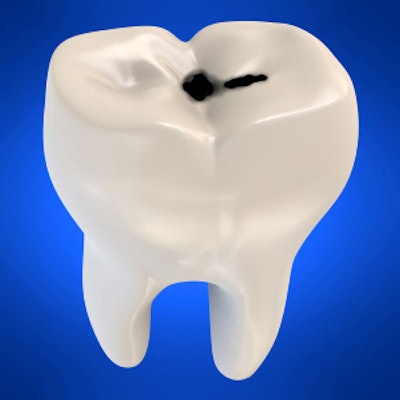
Silver diamine fluoride (SDF) effectively arrests caries in primary teeth, according to a review by researchers in China and Japan and published online in JDR Clinical & Translational Research. The noninvasive, easily administered treatment can manage dental caries in young children or those who have special needs, they noted.
Early childhood caries remain a "global health problem," with dietary sugars, poor oral hygiene, adverse socioeconomic conditions, and more contributing to the issue, noted lead study author Sherry Gao, a doctoral student at the University of Hong Kong Faculty of Dentistry, and colleagues.
"SDF is low-cost and does not require sophisticated instruments or techniques for application," they wrote (JDR Clin Trans Res, August 15, 2016). "It is a cost-effective agent to manage dental caries."
'Silver bullet' for caries?
“SDF is low-cost and does not require sophisticated instruments or techniques for application. It is a cost-effective agent to manage dental caries.”
Silver diamine fluoride, which has been touted as an effective treatment by many in the dental community, was classified as a fluoride in 2014 by the U.S. Food and Drug Administration (FDA). It is a colorless ammonia solution containing silver and fluoride ions that leaves a highly remineralized surface zone rich in calcium and phosphate on the carious lesion, according to the authors.
However, questions remain about the precise formulation and safety of its use on primary teeth. So researchers from the University of Hong Kong and the Tokyo Medical and Dental University sought to investigate the clinical effectiveness of SDF in stopping caries in children.
The researchers examined more than 1,100 studies initially. They eventually focused on eight studies that used 38% SDF on primary teeth, eliminating those studies that used different formulations or focused on permanent teeth. The eight studies included in the review contained more than 6,500 patients.
At a 38% solution, SDF can effectively arrest caries among children, the researchers found. Overall, the treatment arrested 81% of active caries (p < 0.0001), according to the eight studies reviewed. The effectiveness at six-month intervals is shown in the table below.
| Effectiveness of SDF | |
| Time since treatment | Rate of caries arrest (%) |
| 6 months | 86 |
| 12 months | 81 |
| 18 months | 78 |
| 24 months | 65 |
| 30 months and beyond | 71 |
Even with a high concentration of fluoride (44,800 parts per million in 38% SDF), no significant complications were reported in the eight studies examined, the authors noted.
They concluded that the studies showed several advantages of SDF, including the following:
- SDF performs better than glass ionomer cement or fluoride varnish in arresting caries in primary teeth.
- Caries removal is not necessary before application.
- SDF has a relatively low cost for treatment.
- The application does not require sophisticated instruments or techniques.
- The application is painless and can be used for young children or patients with special needs.
Varied application
The only significant complication of SDF treatment is that it stains arrested lesions black, the authors noted. They also reported that the application of SDF varied across the eight studies examined.
"SDF treatment is noninvasive and easily operated," the authors concluded. "It can be a promising strategy to manage dental caries in young children or those who have special needs."



















